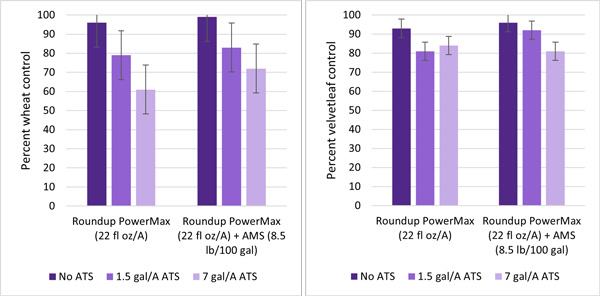With spring burndown applications well underway, we’ve recently had some questions about mixing ammonium thiosulfate (ATS) with herbicides. As addressed in some previous eUpdate articles, sulfur fertility needs of wheat, corn, soybean, and canola may require sulfur fertilization. ATS is a popular liquid fertilizer used to meet these requirements. There are two main topics to address with regard to mixing ATS with herbicides: using ATS as a carrier for ‘weed and feed’ applications; and using ATS as an ammonium sulfate (AMS) replacement.
Ammonium thiosulfate as a carrier for herbicides. The volume of ATS typically needed for sulfur fertilization requirements is likely lower than the desired spray volume for a herbicide application. Hence, using ATS as the sole carrier for a herbicide application is an unlikely scenario. The needed rates of ATS could be included in the carrier volume needed; however, it is important to recognize that ATS is more prone to physical incompatibility than urea ammonium nitrate (UAN). One rule of thumb to reduce the risk of incompatibility is to keep the amount of ATS in the tank mix to less than 10% of the total solution. Another tip is to add ATS to the tank last. When in doubt about the physical compatibility of a tank mix, consider a jar test. Also, we’d be remiss if we didn’t remind you to check your product label(s) for specific tank mixing instructions.
In addition to physical incompatibility, ATS can reduce the efficacy of burndown herbicide applications. Weed scientists at Purdue conducted a greenhouse study to evaluate wheat and velvetleaf control 14 days after treatment by glyphosate and 2,4-D applied with AMS and ATS. The data for glyphosate (Roundup PowerMax at 22 fl oz/A) applied with AMS (8.5 lbs/gal) and ATS (0, 1.5, and 7 gal/A) are summarized in Figure 1. Both wheat and velvetleaf control was reduced when ATS was included in the treatment. In addition, the spray solution pH increased from 4.6 to 5.4 when ATS was included at 1.5 gal/A and to 6.3 at 7 gal/A. This has implications for the use of ATS as an AMS substitute.

Figure 1. Wheat (left) and velvetleaf (right) control by Roundup PowerMax applied with and without AMS and ATS in a greenhouse study. Data from Johnson et al. 2019.
Ammonium thiosulfate as a replacement for ammonium sulfate. AMS is an important water conditioner and adjuvant that comes in both liquid and dry products. The price of dry AMS is attractive, but handling the bags is not. So, if a person wants to apply sulfur, they may wonder if they can apply ATS and forego adding AMS. Even though both products contain ammonium and sulfur, they do not behave similarly when used as a water conditioner. First, the fertilizer analysis is different, with AMS being 21-0-0-24 and ATS 12-0-0-26. Thus, when applied at the same rate of sulfur, ATS will apply less N (ammonium). Second, AMS contains sulfate (SO42-), while ATS contains thiosulfate (S2O32-). These may seem like small changes, but they affect how the products react in hard water (see a companion article in this eUpdate issue on hard water and spray applications). When weak acid herbicides like glyphosate, glufosinate (Liberty, others), 2,4-D, and clethodim (Select, others) are mixed with hard water, dissolved minerals like calcium, magnesium, iron, and sodium, which are positively charged, bind to the negatively charged herbicide and prevent absorption. Both AMS and ATS will dissolve in water, making ammonium (NH4+) available to interact with herbicides. The ammonium salts of the herbicides are readily absorbed across the plant leaf surface. When AMS is dissolved in water, the minerals preferentially bind to sulfate, preventing them from binding to the herbicide. When ATS is dissolved in water, thiosulfate does not react with calcium, magnesium, or iron as readily as sulfate.
In addition, ATS influences solution pH differently than AMS. While AMS slightly decreases solution pH, ATS is likely to increase the spray solution pH, which may influence herbicide performance through enhanced degradation or other methods.
For more detailed information, see the “2025 Chemical Weed Control for Field Crops, Pastures, and Noncropland” guide available online at https://bookstore.ksre.ksu.edu/pubs/SRP1190.pdf or check with your local K-State Research and Extension office for a paper copy.
The use of trade names is for clarity to readers and does not imply endorsement of a particular product, nor does exclusion imply non-approval. Always consult the herbicide label for the most current use requirements.
Sarah Lancaster, Weed Management Specialist
slancaster@ksu.edu
Dorivar Ruiz Diaz, Soil Fertility Specialist
ruizdiaz@ksu.edu
Tags: herbicide application ATS ammonium thiosulfate herbicide carrier adjuvant